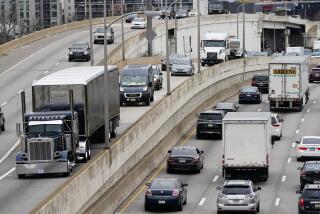In Harness With Safety
- Share via
The National Transportation Safety Board has suggested that rear-seat passengers in cars involved in head-on collisions may have a better chance of avoiding death or serious injury if they aren’t wearing lap belts. The board, an independent federal agency that investigates major transportation accidents, concedes that its tentative conclusion is based on relatively sparse information. The agency looked at only 26 accidents involving 50 people wearing lap belts. What it found was that a lot of those passengers sustained major abdominal, spinal or head injuries from a jackknifing effect that “probably would not have occurred if the lap belts had not been worn.”
In an immediate response the National Highway Traffic Safety Administration, which sets vehicle safety standards, said that its own studies involving thousands of accidents show that lap belts are of major importance in protecting rear-seat passengers. That is particularly the case in rear-end or side collisions and vehicle roll-overs. What the standard-setting agency did not argue with, but at the same time did not endorse, was the safety board’s proposal that rear-seat passengers should have the same kind of protection from shoulder harnesses that front-seat passengers now have.
Both Ford and General Motors are in fact planning to phase in rear-seat shoulder harnesses in coming years, with all models being so equipped by 1989. A number of foreign car models already provide rear-seat shoulder harnesses as standard equipment. They are unobtrusive and, if their proven value to front-seat wearers is any guide, should considerably decrease injuries that occur when an unrestrained body is propelled into sudden and violent motion in a crash.
The 1987 auto model year will begin next month, too late to make rear-seat shoulder harnesses mandatory. But by the 1988 model year such belts ought to be required on all cars. The equipment is in hand, and with most if not all cars there is probably little need for design changes to have it installed. Those who ride in back deserve the same protection as those who ride in front. Shoulder harnesses work. But first they have to be made available so that they can be used.






